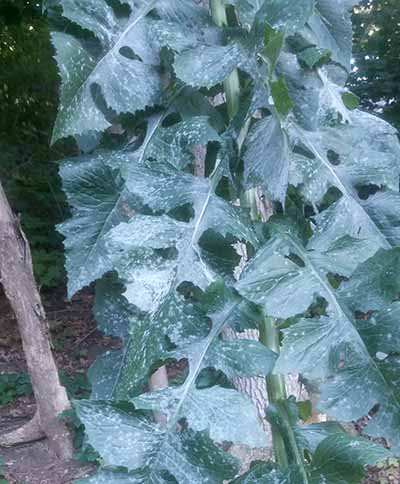Wild lettuces reaching impressive size this growing season
Wild lettuce varieties have similar leaves, flowers and tall stems, and may be towering over other plants in the area.

This 2015 growing season, conditions have been ideal for many native plants or those that have been here so long they think they are native. If you read books about wild plants, they will give you a span of sizes the plant could be. It might say, “1 foot to 5 feet tall,” but this year, that 5-feet tall number might be 8 feet tall. Gardeners who are used to looking at certain plants in the eye or looking down at them because of that plant’s height now feel they are in an episode of “Honey, I Shrunk the Gardener.” Michigan State University Extension educators and Master Gardener hotlines are handling questions every day about giant plants. Those who use the Ask an Expert website are sending pictures of that green Godzilla growing behind their houses. This, coupled with the report of a single giant hogweed plant being found in Calhoun County, have gardeners, hikers and outdoor folks all over the state on high alert.
There are several kinds of wild lettuce plants that can be found in Michigan that can exhibit some impressive size about the time they are flowering. These are not like garden loose lettuce plants that fit comfortably in a salad bowl. As these wild ones grow from a dinky rosette of leaves at ground level to a robust flowering stalk, they may be 7 feet tall or larger now. Most of the wild lettuce varieties can be consumed when they are less than 8 inches tall. As they grow taller, they become so bitter that only a horse would appreciate them. Caution: Large quantities of young, raw leaves can cause digestive upsets involving having to sleep in the bathtub, just in case.
All these wild lettuces can reproduce by seeds that are similar to a dandelion seed with a little “floatie” on the top to blow it to new areas. Most wild lettuce species have a milky juice or sap when a leaf is removed and a deep taproot. Since so little separates all the lettuce varieties, if you can just identify them as “wild lettuce,” you have done well.
Wild lettuce
Wild lettuce, Lactuca canadensis, can be a very tall, smooth plant with many whitish, insignificant flowers on the branched flower heads. The exact leaf shape is extremely variable. It is often found growing on roadsides, wood edges or on disturbed soil. This is one of the most common types of wild lettuce to find and is a native plant. It is a winter annual, which means seeds germinate in late summer or early fall and grow to bloom next year. It can grow to over 7 feet tall.
Prickly lettuce
Prickly lettuce, Lactuca serriola, is an alien plant that can be an annual or biennial. Leaves are bluish-green and edges are prickly. It has pale yellow flowers drying to blue.
Hairy lettuce
Hairy lettuce, Lactuca hirsute, is a native lettuce that may have small hairs on the lower portion of the stem and leaves. There is one type that only has a few hairs on the midrib of the leaf and it is the most common.
Blue lettuce
There are several plants grouped within blue lettuces. Lactuca pulchella is a perennial that can reproduce with either seeds or spreading horizontal roots that produce new shoots. Lactuca floridana and L. villosa can grow to over 7 feet tall and are annuals. L. biennis is the tallest at 15 feet and very leafy. Depending on the species, flowers will range from pale bluish to purplish, drying to white. Other blue lettuces have white to yellow flowers. Leaves are alternately arranged on the stems and can be lobed or un-lobed. All blue lettuces are native plants.

Close-up of blue lettuce leaves.
The take-home message for wild lettuce varieties is that leaves, flowers and tall stems are very similar and may be towering over other plants in the area. The deeply cut leaves are dandelion-like and the flowers are also similar in shape to dandelions.
Smart gardeners will be augmenting their book collections to include good reference books such as “A Field Guide to Wildflowers” by Peterson and McKenny, “Edible Wild Plants – A North American Guide,” an Outdoor Life book and “Stalking the Wild Asparagus” by Euell Gibbons.



 Print
Print Email
Email